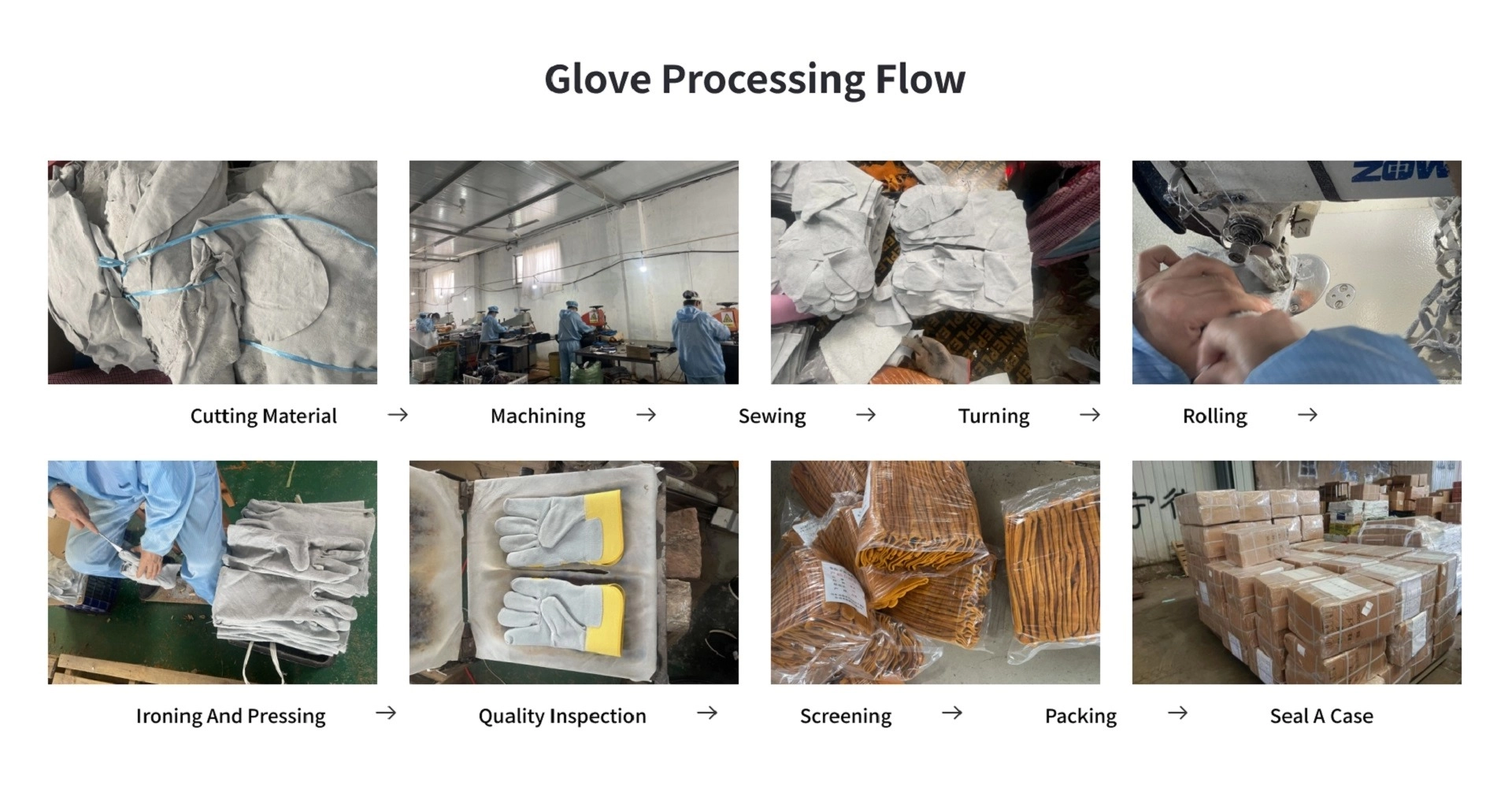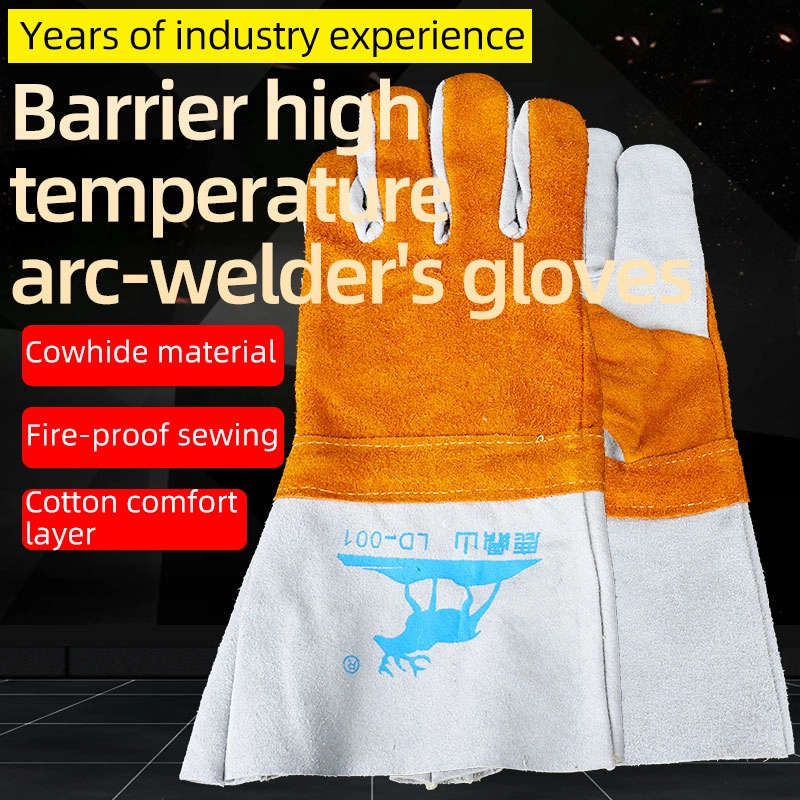Everything You Need to Know About Heat-Resistant Gloves: Your Guide to Using Heat-Resistant Gloves
This article is a comprehensive guide to heat-resistant gloves, explaining their importance in workplace safety and how to choose the right ones for your needs. We'll dive into the different types of heat-resistant gloves, materials, safety standards, and factors to consider when making your selection. Whether you're a seasoned professional or new to the field, this guide will equip you with the knowledge you need to safeguard your hands. This article is worth reading because it provides a clear, concise, and practical understanding of heat-resistant gloves, ensuring you make informed decisions to protect workers and enhance workplace safety.
Understanding Heat-Resistant Gloves: What Are They and Why Are They Important?
Heat-resistant gloves are a crucial piece of PPE (Personal Protective Equipment) designed to protect your hands from high temperatures. They provide excellent hand protection against heat, flames, and sparks. In many industries, workers are exposed to high temperatures, making heat-resistant gloves an essential part of workplace safety. These gloves provide a layer of protection, reduce the risk of burns and other injuries, and help maintain worker productivity by minimizing downtime due to hand protection. They are safety gloves.
Gloves often come in various heat resistance levels, depending on the materials used and the construction of the glove. They are not just for welders; you can choose the right heat-resistant gloves to protect your hands. From manufacturing to food service, the need for heat-resistant gloves is widespread. Understanding the different types and the importance of using them is the first step in creating a safer workplace safety. It is a cornerstone of worker safety.
“Safety isn’t just a priority; it’s a value. When we prioritize safety, we invest in the well-being of our employees and the success of our business.” - Allen (Factory owner)
What are the Key Factors to Consider When Selecting the Right Heat-Resistant Gloves?

When selecting the right heat-resistant gloves, several factors are key. First, consider the hazard and the level of protection required. Heat-resistant gloves offer varying levels of heat resistance, so it’s crucial to match the glove to the specific application. The right choice depends on the exposure to high temperatures, the duration of exposure to high temperatures, and the presence of other hazards, such as cut resistance or chemical exposure.
Second, evaluate the materials include that make up the glove. Common materials include leather, aramid fibers (like Kevlar), silicone, and other synthetic materials. Each material offers different levels of heat resistance, durability, and dexterity. For instance, some heat-resistant gloves often include Kevlar for superior heat resistance and cut resistance. Gloves often also feature insulation layers for added heat protection. Finally, remember to consider flexibility and dexterity. Gloves provide excellent heat protection, but they must also allow for sufficient dexterity to perform the required tasks safely and effectively.
What Safety Standards Should You Know About for Heat-Resistant Gloves?
Safety standards are essential when it comes to protective gloves. These standards ensure that protective gloves meet specific requirements for heat resistance, durability, and other performance characteristics. The safety standards help protect workers. For instance, heat-resistant gloves may be tested to meet standards set by organizations like the American National Standards Institute (ANSI) and the European Committee for Standardization (CE). These standards define the level of protection a glove provides against heat and other hazards.
Here's a table that simplifies the essential safety standards and their importance:
| Standard | Description | Importance |
|---|---|---|
| ANSI (USA) | Sets performance requirements for protective gloves, including those that are heat-resistant gloves. These requirements cover heat resistance, cut resistance, etc. | Helps to ensure a minimum level of protection for workers against various workplace hazards. |
| CE (Europe) | The CE marking indicates that a glove complies with European Union safety standards. | Indicates that the glove has met essential health and safety requirements, providing a reliable layer of protection. |
| Welding Standards | Specific standards may apply to welding gloves, specifying requirements for heat resistance, flame resistance, and dexterity. | Essential for welders, providing hand protection against high heat, sparks, and other welding-related hazards. |
When selecting gloves, always check for these certifications. Ensure the protective gloves meet the required safety standards for your industry and application. Furthermore, always make sure that your safety gear is up to date and meets your local and national standards. Knowing these standards ensures you choose the right heat-resistant gloves and that your workers have protective gloves provide adequate protection.
What Are the Different Materials Used in Heat-Resistant Gloves and Their Properties?
The materials include used in heat-resistant gloves play a crucial role in their heat resistance, durability, and overall performance. Different materials include offer different benefits, making it important to understand their properties.
Here's a breakdown of some common materials:
- Leather: Leather work gloves are known for their durability and abrasion resistance. Leather is often used in welding gloves because it can withstand high temperatures and offers good heat resistance. It's important to note that leather gloves might stiffen when exposed to high heat, and not all leather provides the same level of protection.
- Kevlar and Aramid Fibers: Gloves include Kevlar, which are known for their heat resistance and cut resistance. Materials include Kevlar designed to protect against both heat and cut hazards. They can withstand high temperatures and are often used in manufacturing and other work gloves applications.
- Silicone: Silicone gloves are designed for high-temperature applications. Silicone gloves can withstand high temperatures without melting or degrading. Silicone is also flexible, allowing for sufficient dexterity. It's a good glove material for tasks exposed to high temperatures such as baking or handling hot objects.
- Neoprene and Nitrile: While not primarily known for heat resistance, these synthetic materials include resistance to chemicals and abrasion. Therefore, nitrile gloves might be used in environments where there is a hazard that is not heat related, or in combination with other heat-resistant layers to provide a more comprehensive layer of protection.
The choice of material depends on the specific application and the types of hazards involved. For instance, welders might use leather or aramid fiber gloves, while workers in food service may prefer silicone or nitrile gloves.

How to Choose the Right Heat-Resistant Gloves for Your Specific Needs?

Selecting the right heat-resistant gloves requires careful consideration of the task and potential hazards. Start by assessing the specific work environment. What temperatures will the workers be exposed to high? Are there other hazards such as cuts, abrasions, or chemical exposure? Knowing the answers to these questions will help you choose the right protective gloves. Choosing heat-resistant gloves is not only important, but also a fundamental component of workplace safety.
Consider the level of protection needed. Heat-resistant gloves offer varying levels of heat resistance. Some are designed for brief contact with high heat, while others can withstand high temperatures for extended periods. The amount of time the hands will be exposed to high temperatures is important. For prolonged exposure to high temperatures, gloves with multiple layers and superior heat resistance are required. The right choice depends on the specific work environment and the hazard involved.
Next, assess the need for dexterity. Some tasks require a high degree of dexterity, and the gloves must allow for precise movements. Gloves that are too thick or stiff can hinder work performance and increase the risk of accidents. Also, evaluate comfort and fit. Gloves that fit well and are comfortable will encourage workers to wear them consistently. Ill-fitting gloves can be cumbersome, reduce dexterity, and may lead to worker discomfort or fatigue. Look for gloves that come in various sizes.
How to Properly Care for and Maintain Your Heat-Resistant Gloves?
Proper care and maintenance are essential to extend the life and ensure the effectiveness of your heat-resistant gloves. Regular inspection is the first step. Before each use, inspect your heat-resistant gloves for signs of wear and tear. Look for cuts, tears, cracks, or any other damage that could compromise their heat resistance. Gloves that show any signs of damage should be discarded or repaired. Regularly inspect gloves to maintain worker safety.
Cleaning your gloves often is also important. Follow the manufacturer's instructions for cleaning. Some gloves can be washed with mild soap and water, while others require specialized cleaning. Always make sure that gloves are completely dry before storing them. Store gloves properly. Store your heat-resistant gloves in a clean, dry place, away from direct sunlight and extreme temperatures. Avoid storing gloves in direct sunlight, as this can damage the materials include and reduce their effectiveness. Storing gloves correctly helps extend the life and ensures they are ready for use when needed.
Finally, replace gloves when necessary. Even with proper care, gloves will eventually wear out. Replace gloves when you see signs of wear and tear. If the gloves have been exposed to significant high temperatures, gloves might lose their effectiveness, and the gloves should be replaced even if they don't show any visible damage. By following these care and maintenance tips, you can maximize the life and effectiveness of your heat-resistant gloves and safeguard your hands.
What are Some Common Applications for Heat-Resistant Gloves?
Heat-resistant gloves are used across a wide range of industries and applications where workers are exposed to high temperatures.
- Welding: Welding gloves are one of the most common applications. Welders need heat-resistant gloves to safeguard their hands from sparks, flames, and high heat generated during the weld process. These gloves typically feature leather or aramid fiber construction and offer excellent heat resistance and cut resistance. When welding, always use the appropriate pair of gloves. If you need assistance, read our guide to 10.5 Inch Single Layer Leather Welding Gloves.
- Foundry Work: In foundries, workers handle molten metals and high-temperature materials. Heat-resistant gloves provide adequate protection against burns and allow for dexterity when working with hot objects.
- Manufacturing: Many manufacturing processes involve exposure to high temperatures. Workers in these environments often use heat-resistant gloves to handle hot equipment, parts, or materials.
- Food Service: The food service industry uses heat-resistant gloves to protect workers handling hot ovens, grills, and other cooking equipment. Gloves are particularly important when handling hot pots, pans, and trays.
- Laboratory Work: In laboratories, researchers may work with high-temperature equipment. Heat-resistant gloves are essential for handling hot beakers, test tubes, and other lab instruments.
These are just a few examples of the many applications for heat-resistant gloves. The specific type of glove needed depends on the nature of the work and the specific hazards involved.
Where to Buy Heat-Resistant Gloves and What to Look For?
You can find heat-resistant gloves from a variety of sources, including safety equipment distributors, industrial supply companies, and online retailers. When purchasing heat-resistant gloves, it’s crucial to consider the reputation of the supplier. Look for suppliers with a proven track record of providing high-quality protective gloves that meet relevant safety standards. Also, check for certifications such as ANSI and CE to ensure the gloves provide the necessary level of protection.
Pay attention to the materials include used in the glove and the construction of the glove. The glove should be made from durable materials include that offer good heat resistance, cut resistance, and abrasion resistance. Look for reinforced stitching and durable construction to ensure the gloves can withstand the rigors of the workplace. Check the sizing and fit of the gloves to ensure a comfortable and secure fit for the wearer. Ill-fitting gloves can be cumbersome and may reduce dexterity.
Finally, always read reviews and testimonials from other customers. This can provide valuable insights into the quality, performance, and durability of the gloves. Selecting protective gloves is very important. Read more information about AB Grade 14 Inch Single Layer + Edge Strip + Fireproof Line to help you choose the right ones. By considering these factors, you can choose gloves that will provide optimal protection and comfort and help keep your workers safe.
What Are Some Potential Problems and Solutions with Heat-Resistant Gloves?
While heat-resistant gloves provide excellent protection and comfort, they can sometimes present challenges. One common problem is reduced dexterity. Gloves that are too thick or bulky can make it difficult to handle small objects or perform precise tasks. The solution is to choose gloves that offer a balance of heat resistance and dexterity. Look for gloves with a comfortable fit and flexible materials include, and consider different designs to find what works best for the job.
Another potential problem is the wear and tear on the gloves. Over time, gloves often experience wear and tear. Exposure to high temperatures, abrasion, and sharp objects can damage the glove, reducing its effectiveness. Regularly inspect your gloves for signs of wear and tear and replace them when necessary. Keep an eye out for gloves that show cuts, tears, or other damage.
A third issue is the potential for discomfort or sweating. Gloves made from certain materials include may not breathe well, leading to sweating and discomfort during prolonged use. Consider using gloves with breathable linings or those made from materials include that wick away moisture. Providing workers with a variety of gloves can help them find the gloves for tasks that work best for them. By understanding these potential problems and implementing the right solutions, you can ensure that your workers are using heat-resistant gloves safely and effectively.
Internal Links to Help You Choose the Right Heat-Resistant Gloves
- 10.5" Suede Leather Yellow Cloth Split Palm Gloves
- 10.5 Inch Single Layer Leather Welding Gloves
- 14'' Black and Golden Yellow Cowhide Welding Gloves
Conclusion: Key Takeaways for Using Heat-Resistant Gloves
- Heat-resistant gloves are essential for hand protection in many industries.
- Choose the right heat-resistant gloves based on the specific hazard, materials include, and safety standards required.
- Regularly inspect, clean, and store your gloves correctly to extend the life and maintain their effectiveness.
- Always prioritize worker comfort and dexterity when selecting gloves.
- Know the safety standards to ensure the protective gloves provide adequate protection.
By following these guidelines, you can ensure that you are using heat-resistant gloves safely and effectively. This will protect workers and enhance workplace safety.






